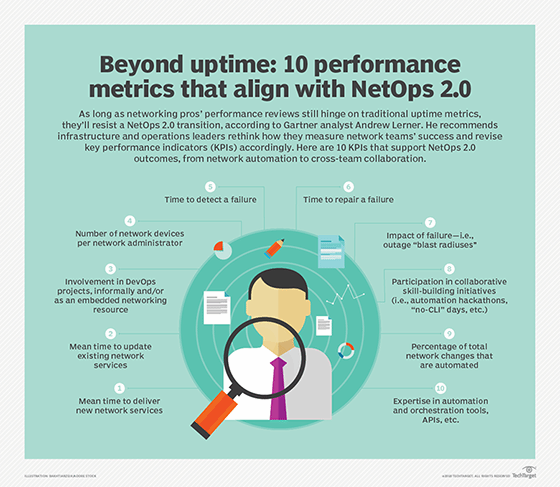The NetOps 2.0 era is here: A primer for networking pros
Experts say inflexible legacy networks impede critical DevOps initiatives. Enter NetOps 2.0. This primer explains how automation and virtualization can help networks evolve.
The term NetOps has two possible meanings:
- NetOps = networking operations. Historically, NetOps has simply been shorthand for network operations, or the running of the network. Some people still use the term NetOps this way today.
- NetOps = networking + DevOps. In other contexts, NetOps refers to a modern networking approach that applies DevOps ideas, such as continuous integration/continuous delivery and infrastructure as code, to network management. This concept is also known as NetOps 2.0, NetDevOps, DevNetOps and network as code.
Traditional network operations require the manual configuration of gear via command-line interface (CLI), a complex and time-consuming process. When the current era of digital transformation dawned in the enterprise, developers started churning out apps and services to meet new business needs at an unprecedented rate. Networks struggled to keep up, becoming a bottleneck in the software development lifecycle (SDLC).
In 2017, Gartner analyst Andrew Lerner cited rigid legacy networks as one of the biggest roadblocks to DevOps initiatives and digital innovation. He coined the term NetOps 2.0 and urged networking pros to embrace principles such as agility, automation by default, programmability, resiliency and scalability.
Since then, NetOps 2.0 technologies -- such as network analytics, automation, orchestration and virtualization -- have become increasingly popular. Proponents say the NetOps 2.0 paradigm better supports the SDLC, turning network infrastructure from a business impediment into a business asset.
NetOps 1.0
Legacy networks are hardware-centric, complex and inflexible. A traditional NetOps 1.0 approach includes the following:
- reliance on manual processes and CLI;
- a reactive rather than proactive mindset -- "If it ain't broke, don't fix it;"
- siloed networking teams, cut off from business units, application developers and security teams; and
- a focus on technology rather than business needs.
Many network professionals inherited a cultural risk aversion that stretches back to the early days of IT. For decades, enterprises issued networking teams a clear mandate: above all else, uptime. In the pre-DevOps environment, availability trumped agility, downtime earned demerits and fortune rarely favored the bold.
Decades of hard, sobering experience taught network engineers to be cautious about change because change can break things. They favored a static network architecture and rigorous change control, executing necessary updates slowly, incrementally and on a case-by-case basis. This led to complex, fragile and ad hoc network designs.
That's why NetOps 1.0 teams typically take a reactive approach to problem-solving, addressing issues as they arise through manually jury-rigged configurations -- each one different and, therefore, each requiring a unique fix when broken. In the short run, NetOps 1.0 promotes maximum network availability with minimal disruption. But, in the process, it creates an unwieldy, complicated infrastructure that is difficult to change or scale.
Even as disruption, innovation and virtualization have radically transformed the systems administration game, many networking teams have continued to function much as they always have. Case in point: According to Gartner, the vast majority of network changes were still manually configured as of 2018.
NetOps 2.0
NetOps 2.0 invokes a new vision for the modern network, along with the tools and tactics for putting that vision into action. It represents a paradigm shift from inflexibility to programmability, with the goal of building nimble, dynamic networks that can quickly adjust to the digital needs of today's enterprise.
NetOps 2.0 includes the following:
- programmatic APIs, automation, intent-based networking, virtualization and orchestration;
- a proactive and analytics-driven approach to problem-solving;
- meaningful engagement with DevOps and DevSecOps;
- awareness of business goals and outcomes.
By treating infrastructure as code, NetOps 2.0 can simplify, standardize and accelerate provisioning, configuration and management processes. This takes pressure off networking teams to continually re-create the wheel and results in more scalable infrastructure. Continuous updates and testing may also help to improve security, resiliency and stability and prevent future outages.
How to implement NetOps 2.0
Organizations need both top-down and bottom-up initiatives to put NetOps 2.0 into practice, with IT leaders working to do the following:
- recalibrate cultural values by normalizing managed risk-taking;
- reward innovative thinking;
- discourage blame games after network outages; and
- encourage challenges to the status quo.
On the ground, networking pros should work to develop the following:
- programming and automation skills for provisioning and managing infrastructure as code; and
- soft skills for collaborating effectively with DevOps and DevSecOps teams, both informally and as embedded team members on particular projects.
Lerner suggested team- and skill-building through grassroots initiatives, like automation hackathons and "no-CLI" days. He also recommended adding NetOps 2.0-oriented performance review metrics that reflect shifting network priorities, such as the following:
- time to deliver new services;
- time to detect an outage; and
- automation as a percentage of total network changes.

While uptime -- the indicator on which networking pros have traditionally been assessed -- remains critical, it takes more than availability to succeed in a NetOps 2.0 world.







